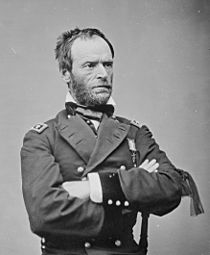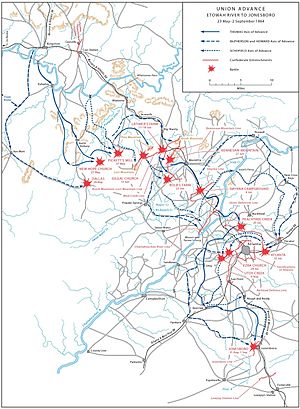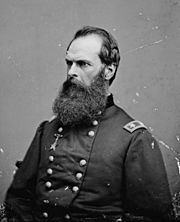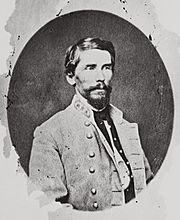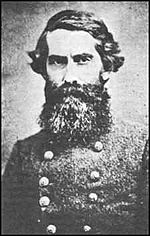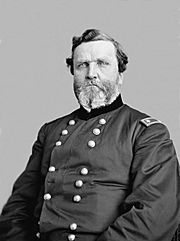Battle of Gilgal Church facts for kids
Quick facts for kids Battle of Gilgal Church |
|||||||
|---|---|---|---|---|---|---|---|
| Part of the American Civil War | |||||||
 Wartime photograph shows Pine Mountain near where General Polk was killed. |
|||||||
|
|||||||
| Belligerents | |||||||
| Commanders and leaders | |||||||
| William T. Sherman Joseph Hooker |
Joseph E. Johnston William J. Hardee |
||||||
| Units involved | |||||||
| Military Division of the Mississippi | Army of Tennessee | ||||||
| Strength | |||||||
| June 10–19: c. 100,000 | June 10–19: c. 65,000 | ||||||
| Casualties and losses | |||||||
| Gilgal Church: 650–734 Latimer's Farm: unknown |
Gilgal Church: 250 Latimer's Farm: 200 |
||||||
The Battle of Gilgal Church happened on June 15, 1864. It was part of the Atlanta Campaign during the American Civil War. The Union Army led by William Tecumseh Sherman fought against the Confederate States Army led by Joseph E. Johnston.
This battle was one of many smaller fights between June 10 and 19, 1864. These battles took place along a long line from Lost Mountain to Pine Mountain and Brushy Mountain in Georgia. At Gilgal Church, Union soldiers from Joseph Hooker's XX Corps attacked. But Confederate soldiers from William J. Hardee's corps fought them off. The Union army lost about 700 soldiers. On the same day, other Union troops captured about 300 Confederate soldiers. The Battle of Gilgal Church was part of a series of smaller fights, including the Battle of Latimer's Farm on June 17–18.
After the Battle of Dallas on May 28, Sherman's army moved towards the Western and Atlantic Railroad at Acworth. On June 4, Johnston's army left their positions near Dallas and New Hope Church. They moved to new defensive lines. Sherman's army got stronger with more troops. On June 10, he started his attack again. A Confederate general, Leonidas Polk, was killed by an artillery shell on June 14 at Pine Mountain. That night, Johnston's army moved back from Pine Mountain. Sherman's forces followed, leading to the fights near Gilgal Church. After the Union attacks failed, Johnston moved Hardee's corps back to a new line behind Mud Creek. At Latimer's Farm, Union troops gained a small advantage. On June 19, Johnston's army moved back again to strong defenses around Kennesaw Mountain.
Contents
Why the Battle Happened
The Union Army's Plan
General Ulysses S. Grant, the top Union commander, told Sherman to attack Johnston's army. Sherman's goal was to break up the Confederate army and cause as much damage as possible. Atlanta was a very important city for the Confederates. It was a major railroad hub, a place to get supplies, and a manufacturing center. So, Sherman wanted to capture Atlanta.
The Atlanta Campaign began with the Battle of Rocky Face Ridge in early May 1864. Sherman tried to go around Johnston's army, forcing them to retreat to Resaca. After the Battle of Resaca, Johnston retreated again. In mid-May, Johnston planned to attack part of Sherman's army at Adairsville. But his plan didn't work, and the Confederates moved back to a strong position at Allatoona.
Sherman didn't want to attack the strong Confederate defenses head-on. Instead, he tried to move around Johnston's western side. This led to battles like New Hope Church, Pickett's Mill, and Dallas in late May.
Moving Eastward
Sherman's army was stopped by Johnston's defenses. So, Sherman decided to move his forces eastward toward Acworth. On June 1, Union soldiers started moving northeast. On the same day, Union cavalry reached Allatoona, which was not defended. This meant that Sherman's crews could finally repair the railroad tracks. This railroad was vital for bringing supplies to his army.
On June 2, it started to rain, and it rained a lot that month. The muddy roads made it hard to move supplies. As Union forces moved, Johnston decided he had to leave his defenses around New Hope Church. On the night of June 4, the Confederate army moved to a new line of defenses. This line stretched from Lost Mountain to Brushy Mountain. In the middle, Johnston's troops held a strong point called a salient at Pine Mountain. A salient is a part of a battle line that sticks out into enemy territory.
In the two weeks of fighting around Dallas and New Hope Church, Sherman's army lost about 4,500 soldiers. Johnston's army lost about 3,000. Even though Johnston's army had retreated, their spirits were high because they had defended well. By this point, Sherman's army had moved about 80 miles into Georgia. His forces were also getting stronger with more troops. Johnston, however, had fewer options for getting more soldiers.
The Fighting: June 10–19
Pine Mountain Skirmishes
Sherman changed how his forces were lined up. He wanted to push forward again. On June 8, more Union soldiers joined Sherman's army at Acworth. These were 9,000 experienced soldiers. The rain continued, making the roads very muddy. But on June 12, the railroad bridge over the Etowah River was finished. This meant supplies could reach Sherman's army more easily.
On June 10, Sherman ordered his forces to advance. Johnston believed he was greatly outnumbered by Sherman's army. At first, Johnston focused his strength on the left side of his line. But when Sherman moved north to the railroad, Johnston shifted his forces to the right. Union soldiers moved forward, meeting Confederate skirmishers near Pine Mountain. Pine Mountain was a hill about 1 mile long and 300 feet high. Confederate soldiers held this hill with cannons.
On June 14, the weather was sunny and clear. Sherman was looking at Pine Mountain when he saw a group of Confederate officers on top. He ordered his artillery to fire at them. The officers were General Johnston, General Hardee, General Polk, and another officer. They were discussing their battle plans. An artillery shell hit General Polk, killing him instantly. He was hit in the side by a cannonball, which caused a terrible injury. This was a big loss for the Confederate army.
Also on June 14, Union soldiers on the far left side of the line attacked. They captured a ridge that overlooked some Confederate defenses. The Confederates had to pull back.
Battle at Gilgal Church
After General Polk was killed, Johnston ordered the Confederate soldiers at Pine Mountain to retreat. Sherman thought Johnston's whole army was retreating. He ordered his troops to push forward. Union troops did capture some advanced Confederate trenches. But the main Confederate defenses at Gilgal Church remained strong.
Union soldiers from Joseph Hooker's XX Corps attacked the Confederate lines east of Gilgal Church. However, they were strongly pushed back. For several hours, Union troops tried to break through the Confederate lines but failed. They suffered heavy losses, with over 500 soldiers killed or wounded. Other Union troops also attacked Confederate soldiers led by Patrick Cleburne at Gilgal Church. They were also stopped. One Confederate captain said his soldiers tore down the church, log by log, before the fighting began.
The only Union success on June 15 was on the eastern side. Union soldiers charged across a creek and captured some Confederate rifle pits. They took 320 prisoners. But Sherman did not follow up on this small victory.
Sherman hoped that Johnston was about to retreat. On June 16, he ordered his central army to push forward. But the Union commander, General Thomas, decided to use his cannons instead. He wanted to blast the Confederates out of their defenses. Union artillery was able to fire on the Confederate defenses at Gilgal Church from different directions. This made it very difficult for the Confederates. Johnston then ordered Hardee's corps to pull back to a new line of trenches. During this retreat, a Union shell badly injured a Confederate general, Lucius E. Polk. He was a nephew of the general who had been killed earlier.
Fighting at Latimer's Farm
On the night of June 16–17, Hardee's corps moved back about 3 miles. They went to a new set of trenches that Johnston had prepared near Mud Creek. On June 17, Union forces advanced, pushing back Confederate cavalry. Union troops captured an island in Mud Creek. This island had a hill that was a good spot for cannons. From this hill, Union cannons silenced the Confederate artillery.
General Thomas ordered General Oliver Otis Howard's IV Corps to attack the enemy. Howard's division attacked across an open field. But the Union soldiers were very careful. They had suffered heavy losses in a previous battle. After a long bombardment, Confederate troops retreated. Union soldiers then took over their position.
The new Confederate defense lines were set up in a way that Union cannons could fire on them from the side. Johnston saw this problem and asked his engineers to prepare a new defense line. On June 18, it started to rain again. Mud Creek and Noonday Creek swelled into small rivers. Union soldiers advanced and captured some Confederate outposts, taking 50 prisoners. These actions against the Confederate lines are known as the Battle of Latimer's Farm. The Confederates lost about 200 soldiers in this fight.
What Happened Next
On the night of June 18–19, Johnston's army moved back again. They went to another line of strong defenses around Kennesaw Mountain. Johnston's lines stretched for about 7 miles. This defensive position was probably the strongest Sherman's forces had seen so far. The next battles were the Battle of Kolb's Farm on June 22 and the Battle of Kennesaw Mountain on June 27.
Sherman sent regular reports to his superiors in Washington, D.C. He explained that his progress was slow. He also shared his thoughts about his commanders. He was disappointed with his cavalry leaders. But he was most critical of General Thomas and his army. Sherman felt that Thomas's army was too slow. He wrote that they would stop and dig trenches even at a small obstacle. Sherman wanted them to attack, not just defend.
However, many historians say Sherman's criticism was unfair. Soldiers on both sides quickly dug trenches as soon as they reached a new position. This was because they learned that one soldier in a trench could fight off three or four attackers. When Union soldiers reached a new spot, they would quickly build breastworks or trenches. They cut down trees for logs and dug ditches. The earth from the ditches was piled up to protect the logs. A top log was placed to create a narrow opening for firing. In front of the trenches, they would cut down trees and shrubs to create obstacles for attackers. This made it very hard for the enemy to charge. Confederate soldiers used similar methods. They also used enslaved people and local militia to help build their defenses.


